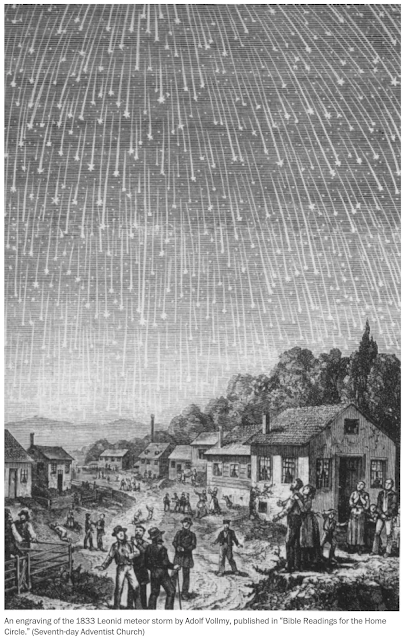Astronomers are reporting that there’s a chance that a “meteor storm” could occur on the night of Memorial Day. It probably won’t happen, but if it does, the display could be absolutely otherworldly... Meteor storms result when Earth enters an unusually dense and intense clustering of interplanetary debris — akin to driving through a swarm of bugs on the highway...Meteor rates could range between one and 1,000 meteors per hour. If a meteor storm occurs, it would only last for perhaps an hour or two, and probably less... Astronomers have pinpointed the most likely time for the peak of whatever display may or may not transpire to be around 1 a.m. Eastern time Monday night/Tuesday morning. The shower’s “radiant” point, or the part of the sky from which meteors appear to emanate, will be high in the sky over North America at that time, so there’s no specific place in the sky to look...A meteor storm came in 1966, igniting an equally splendid fireworks show in the United States. Eyewitness Christine Downing, who drove north of Mojave, Calif., saw a couple of shooting stars every five minutes, which “at the time … seemed extraordinary.” At 12:30 a.m., it began “raining stars,” and by 2 a.m. “it was a ‘blizzard.’ ”Her description, which can be read in full on a NASA Web page, is one of many from that night. “There was the unnerving feeling that the mountains were being set on fire,” Downing wrote. “Falling stars filled the entire sky to the horizon, yet it was silent.”
More info and historic reports at The Washington Post.
Addendum: no storm - not even a decent shower.

Yeah. Headlines containing words like may, could and possible are usually to be taken with a medium sized salt mine. All too often I've been tempted to stay up late to watch one of these "meteor storms," only to freeze my behind off and spot three flimsy streaks across the sky at most. Even if this one were to hit 1000 meteors per hour, which would definitely be impressive, it "only" comes down to one meteor in about 3.5 seconds on average (as opposed to the 50,000-150,000 meteors per hour in the 1833 storm). Still, it would be absolutely awe-inspiring to watch a proper one in person, so who knows I'll give it another go :)
ReplyDeleteI checked twice, at 0030 and 0130. What I experienced was *crickets* [literally].
DeleteThank you for staying up so late and checking for us!
Delete10:30 PM PST. Time to lock-up the free-ranger chickens. Sleeping hens, but no falling stars. Fun to seek, if not to find.
ReplyDeleteI watched for an hour or so around the "predicted" time of 10PM PDT and saw one. That is about half of a normal hour.
ReplyDeleteI have gone out for the regular showers since YMCA camp in about 1950, and never seen a top-notch one.
I kind of looked forward to the Leonids in 1966 but the Army preferred to put me in a triple canopy jungle in the monsoon: poor viewing conditions.